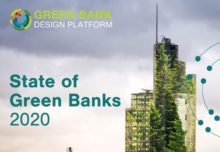
Bron
RMI
The State of Green Banks 2020 report released today by Rocky Mountain Institute, Green Finance Institute, and the Natural Resources Defense Council provides a comprehensive review of green bank activities and their potential worldwide. A green bank often is a specialized financing institution that acts as the focal point for scaling up domestic investment in climate solutions.
The report reviews the impact and development of green banks in 36 countries. It aims to provide an understanding of green bank activities around the world that policymakers, funders, development finance institutions, and others can use to further the global green bank movement. It makes the case for green banks by highlighting the application of different green bank models across multiple geographies. In addition, the report will help guide the development of the Green Bank Design Platform, which aims to support governments and institutions in the establishment of green banks and other green financing vehicles.
The State of Green Banks 2020 report is being launched at the Finance in Common Summit on November 11th at 17:00 CET, during a panel titled “State of Green Banks 2020: a Global Movement in the Making.” The Summit, which will be attended by public development banks and Heads of State from around the world, will aim to raise the ambition for a sustainable post-COVID recovery to benefit societies and the planet. The panel, moderated by Rhian-Mari Thomas of the Green Finance Institute, will feature an overview of the report followed by a discussion with Muhammed Syed from the Development Bank of Southern Africa, Teddy Mugabo from the Rwanda Green Fund (FONERWA), and Susana Escária from Portugal’s Ministry of Environment and Climate Action. The panelists will share their experiences in setting up green banks and provide information on the role these institutions will play in helping their countries and regions achieve climate and development targets.
Currently, there are 27 operational green banks around the world which have invested more than $20 billion to date in new technologies ranging from rooftop solar to vehicle electrification and energy efficiency. In order to attract private investors into these markets, green banks use a range of financial instruments, including those that mitigate risk, and they are often the first to invest in new technologies and geographies. As a result, green banks have attracted over $2 of private investment, on average, for every $1 of own capital they invested into a project.
An additional 25 countries are exploring setting up a green bank, with interest noticeable across all regions and all country income levels. Many green finance institutions are being set up to attract private investment and concessional finance, as well as to achieve Nationally Determined Contributions (NDCs) Paris Agreement on climate change, with the expectation that they will also improve air and water quality and spur economic development through job creation.
Report findings were collected by Rocky Mountain Institute between June and September 2020, with 46 surveys and 15 interviews conducted with representatives from 36 countries. The State of Green Banks 2020 report is available here: rmi.org/insight/state-of-green-banks-2020/.
Speaking about the report, Dr Rhian-Mari Thomas, chief executive at the Green Finance Institute, says: “Over the recent years we have seen a global surge in green bank activity. There are already 27 operational green banks in 12 countries and a further 25 countries are exploring the possibility of establishing one themselves. As a result, green banks look set to play an important role in reaching global climate targets and sustainable development goals. What this report illustrates is that even though green banks are vital, obstacles still stand in the way of more being launched. We collectively have to shift the dial, to ensure that the political will and financing is there to allow more of these institutions to be established.”
Doug Sims, Director and Senior advisor at NRDC’s Green Finance Center, says: “After mitigation and adaptation, mobilizing finance is the third pillar of the Paris Agreement and is the necessary precondition for the success of the other two. To be equitable and sustainable, finance has to rooted in national priorities and responsive to local needs. And to get to scale, it must connect to international networks. State of Green Banks 2020 demonstrates that in every region of the world, countries are turning to green banks to marshal resources in service of green and equitable transformation.”
Paul Bodnar, Managing Director at Rocky Mountain Institute, says: “Meeting the goals of the Paris Agreement represents a massive financing challenge for all nations adopting ambitious emissions targets and readying for the unavoidable impacts of climate change. State of Green Banks 2020 shows the rapid emergence of this replicable approach to climate finance, grounded in local realities and priorities rather than international institutions.”






